The oleander plant (Nerium) is a member of the Kutrov family. According to data taken from various sources, this genus unites 3-10 species. The Latin name for such a culture comes from the Greek word "nerion", which translates as "raw" or "wet". The area where the oleander grows must have groundwater located close enough to the surface of the soil, at the same time, this culture is resistant to heat. It is found naturally in the subtropical regions of the Mediterranean. Such a flower is poisonous, however, substances are extracted from its foliage that are used for the manufacture of medicines that are prescribed for disorders of the cardiovascular system. If you inhale the smell of indoor oleander flowers for a very long time, it can cause headaches. Large flowers are pink, red, white or yellow in color. The most common type of oleander (Nerium oleander) is grown at home. Thanks to breeders, a large number of forms of such a plant with various flowers were born. If the bush is placed in a well-lit place, then in a short time it can reach a height of 200 cm.
Content
Brief description of cultivation
- Bloom... June – October.
- Illumination... Needs bright sunlight.
- Temperature regime... In spring and summer - from 20 to 28 degrees, in autumn - about 18 degrees, and in winter - 8-18 degrees.
- Watering... In spring and summer, watering is carried out immediately after the top layer of the substrate dries out, while the water remaining in the pan after watering is not poured into the intense heat. In the autumn-winter period, you can wait until the soil mixture dries out to a great depth.
- Air humidity... Should be moderate. However, in the hot season, it is recommended to put the flower pot on a pallet filled with moistened expanded clay.
- Fertilizer... In spring and summer, the bush is fed 2 to 4 times a month, for this they use mineral fertilizer for flowering plants. Top dressing is carried out after 30 minutes. after watering.
- Dormant period... From November to the last days of February.
- Pruning... Immediately after the bush has faded.
- Transfer... In the last weeks of spring. Young bushes are transplanted once a year, and adult specimens - once every 2 or 3 years.If the bush is very large, then annually in spring it will need to change the top layer of the soil mixture in the container.
- Soil mixture... Peat, sand, humus, turf and leafy land (1: 1: 1: 2: 1).
- Reproduction... Seed method and cuttings.
- Harmful insects... Mealybugs, scale insects, spider mites and aphids.
- Diseases... If you take care of the bush incorrectly or provide it with inappropriate conditions of detention, this can have an extremely negative effect on its decorative effect.
- Properties... This plant is poisonous, but medicines for heart diseases are made from its leaf plates.
Oleander home care
Illumination
When grown at home, oleander needs a lot of light, only in this case the bush will be thick and beautiful. If the pot is on a north-facing windowsill, then experts recommend supplementing the flower with fluorescent lamps. The fact is that with a lack of light, all the foliage begins to fly from the bush. The room where the plant is located must be regularly and well ventilated. In summer, the bush should be placed in a well-lit place, while providing good ventilation. If it was bought quite recently, then it must be gradually accustomed to bright light, as well as to direct rays of the sun.
Temperature regime
The room in which the flower is located must be systematically ventilated. In the spring and summer, the temperature in it should be from 20 to 28 degrees. With the onset of the autumn period, the temperature must be lowered to 18 degrees, and in winter, the oleander is removed to a well-lit and cool (8-15 degrees) place. With the onset of March, it is necessary to carry out a gradual increase in the air temperature in the room.
How to water properly
For watering it is necessary to use soft lukewarm (slightly above room temperature) water, while it will be very good if before that it stands for at least 24 hours. In the spring-summer period, watering is carried out immediately after the top layer of the soil mixture dries out. And on hot days, the water that remained in the pan after watering must be left, while when it is cool outside, such liquid must be poured out. In the autumn-winter period, watering is carried out carefully, they do it about 2 days after the top layer of the soil mixture dries out, while it is necessary to ensure that the root system of the bush does not rot. Do not allow the earthen coma to dry out.
Air humidity
It is not necessary to moisten the oleander from the sprayer in spring and summer. In the event that the room is very hot, then the container with the plant is placed on a tray into which water is poured. But in the winter, he will need systematic spraying, because the tips of the leaf plates may begin to dry on him due to the excessively dry air that is dried by heating devices.
Oleander feeding
Top dressing is carried out only in the spring-summer period from 2 to 4 times a month, for this, organic matter and mineral fertilizers are used alternately. Top dressing is carried out only on those days when the weather is not hot, they do it half an hour after watering.
Pruning
It is imperative to prune the oleander, otherwise flowering may not occur or it will be poor. In a faded bush, branches should be shortened by 1/2 or 2/3 parts. Pruned branches can be used as cuttings. The vegetative shoots that grow under the flower buds must be removed, as they slow down the development of the bush.
Oleander transplant
Young plants should be transplanted once a year, and adult specimens - once every 2 or 3 years. The transplant is carried out in the last weeks of spring or the first - in summer. A mandatory transplant is necessary for those bushes in which the root system has ceased to fit into the pot.In this case, a significant part of the roots must be cut off, while the places of the cuts must be treated with charcoal dust, it is also necessary to reduce the clod of earth, so that the bush will bloom more magnificently. A good drainage layer must be made in the container, a suitable soil mixture should consist of peat, sand, humus, turf and leafy soil (1: 1: 1: 2: 1). If the bush is very large, then it will be extremely difficult to transplant it, therefore it is recommended to replace the top layer of the soil mixture in the container with a fresh one every year.
Virulence
If there are children in the house, then it is better not to grow oleanderbecause its root system, foliage, flowers and shoots contain poison. When the work with the bush is over, it is imperative to wash your hands with soap and water. The smell of the flowers of such a plant can cause headaches. It is impossible to eat oleander flowers and fruits, because this may cause vomiting, heartbeat disturbances, and in some cases respiratory arrest is observed. If there are even small wounds on the skin of the hands, then it is impossible to work with oleander, because its juice should never get into the wound.
Reproduction of oleander
Growing from seeds
They sow only freshly harvested oleander seeds, because due to prolonged storage they lose their germination. The seed material needs pre-sowing preparation; for this, it is poured with a solution of a systemic fungicide or potassium manganese for 30 minutes. Then it is soaked for 2-3 hours in a lukewarm solution of Zircon. The seeds are spread over the surface of the substrate (vermiculite, sand and charcoal), then they are covered with a thin layer of the same soil mixture. In the event that the crops are placed in a warm place (from 33 to 35 degrees), then the first seedlings may appear after 7-10 days. If the crops stand in a cooler place, then the seedlings will appear a little later, but there is also a high probability that the seeds will rot.
When the seedlings appear, the crops must be supplemented with fluorescent lamps, while the air temperature must not be allowed to drop below 18 degrees. Systematically moisten the seedlings from the sprayer, and ventilate the seedlings. When the plants have 2 true leaf plates, you can gradually begin to look after them, like adult bushes. Plants are picked into separate pots after 2 more true leaf plates have formed. When oleander propagates by seeds, grown seedlings may lose varietal characteristics.
Propagation of oleander by cuttings
Cuttings are harvested in autumn or spring, their length should be about 15 cm. They are treated with crushed charcoal and wait until they dry. They are planted in perlite, crushed expanded clay, or in a mixture consisting of sand and charcoal. When they are planted, their root collars must be sprinkled with a small amount of sand, which will save them from decay. The soil mixture should be constantly moderately moistened, thanks to this, rot will not appear on the cuttings. The temperature should be about 20 degrees, while the container with cuttings should be in a well-lit place. For rooting, you can also use plain water, but to prevent rot on the cuttings, a small amount of charcoal must be added to the liquid. After about 4 weeks, roots appear on them, they are transplanted into individual pots filled with soil mixture, which includes sod, humus and peat soil, and a small amount of sand.
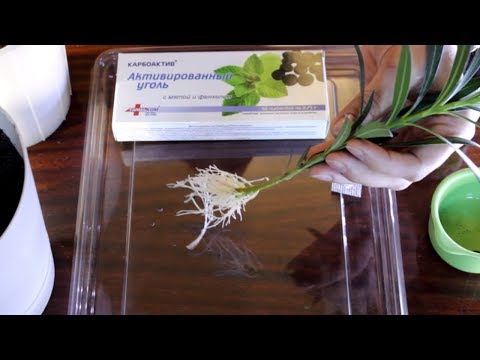

Watch this video on YouTube
Possible problems
- Lack of flowering... If the oleander does not bloom, then this may be due to the fact that in the summer it felt a lack of sunlight.
- Flying around foliage... In the autumn-winter period, with a lack of light, foliage can begin to fly from the bush.
- Poor bloom... Poor flowering of an adult bush may be due to the fact that pruning is not carried out on time, watering is too scarce, there is a lack of nutrients, or the lighting is very poor.
- Pests... Sometimes oleander is affected by cancer (this is a personal disease of such a culture). Most often, scabies, spider mites, worms and aphids settle on the bushes.
The healing properties of oleander
Cardiac glycosides are made from oleander foliage, they are used in the manufacture of medicines to treat disorders of the cardiovascular system.
Oleander species
Common oleander (Nerium oleander)
Either fragrant oleander (Nerium odorum), or Indian oleander (Nerium indicum) - the height of such a large shrub is about 400 cm.Lanceolate leaf plates grow on straight branches, which are short-petiolate or collected in whorls of 3 pieces or opposite. The foliage is about 15 centimeters long and up to 3 centimeters wide. Leathery to the touch, leaf plates have a greenish seamy surface and a darker front surface. The shape of the inflorescences is racemose. Lush inflorescences consist of a large number of flowers that can be colored pink, yellow, red or white. There are forms with variegated flowers.
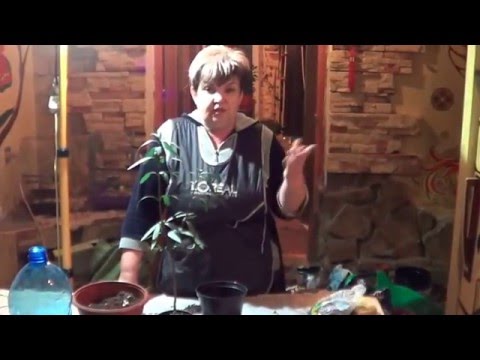

Watch this video on YouTube

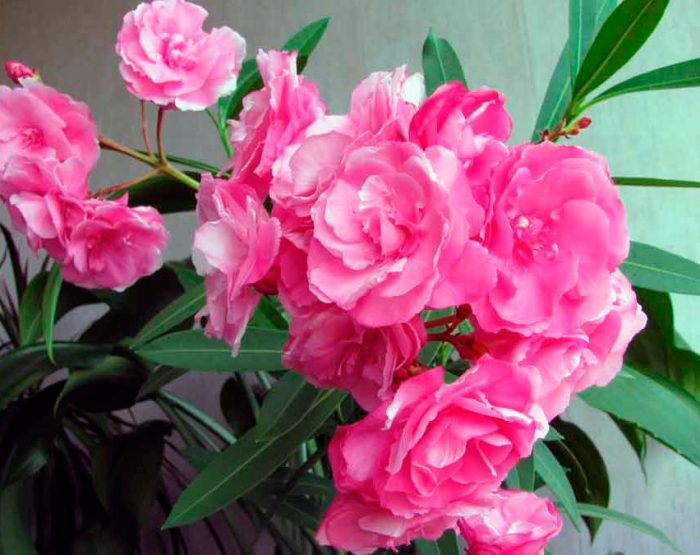
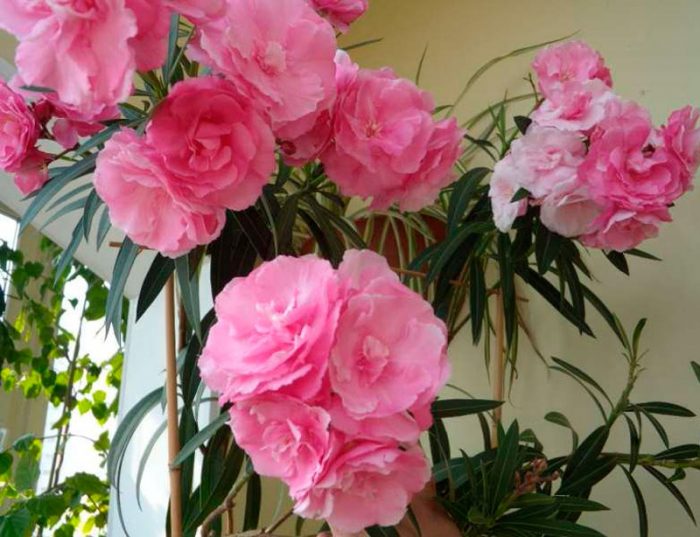
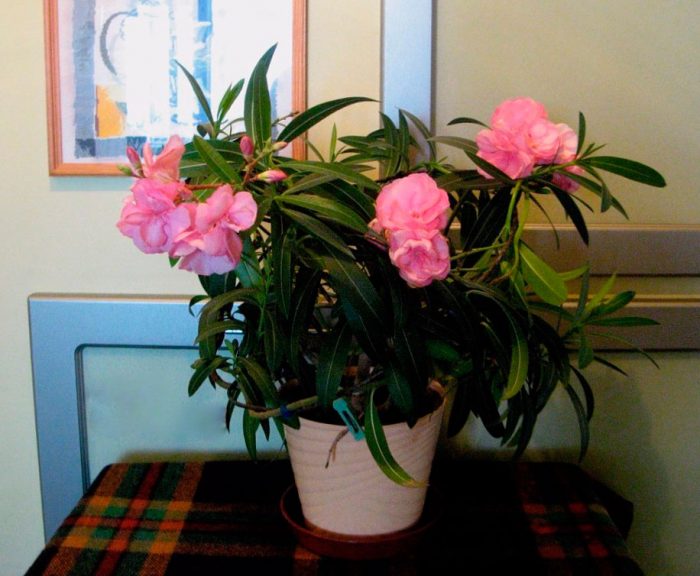
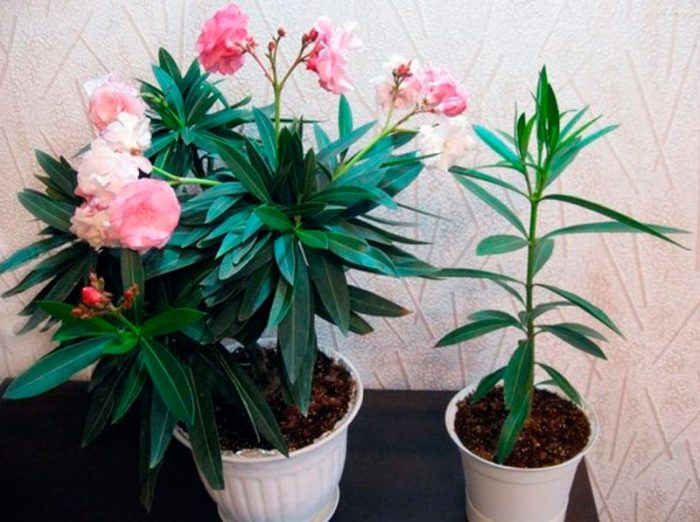
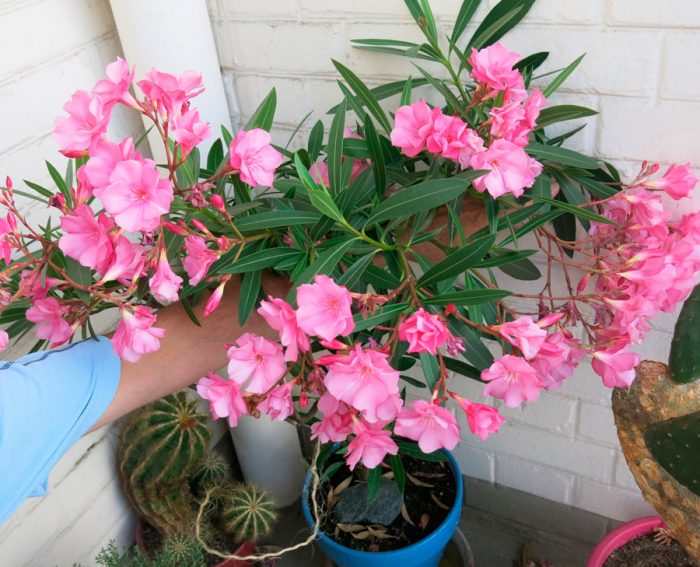
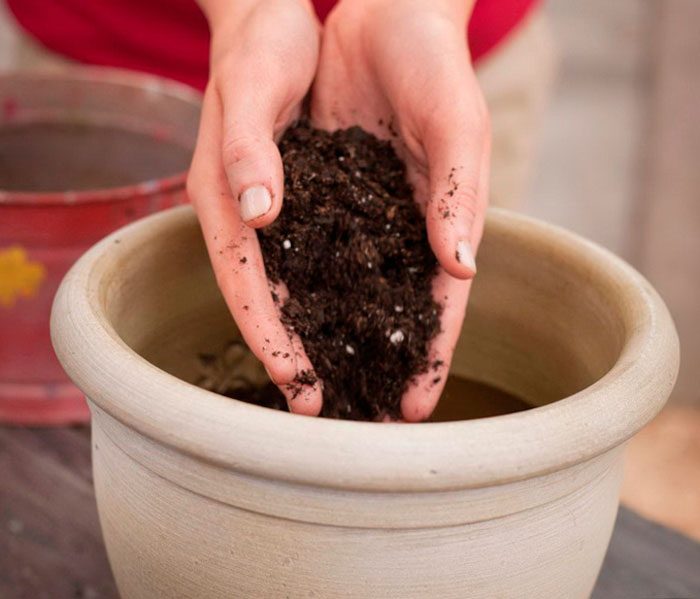
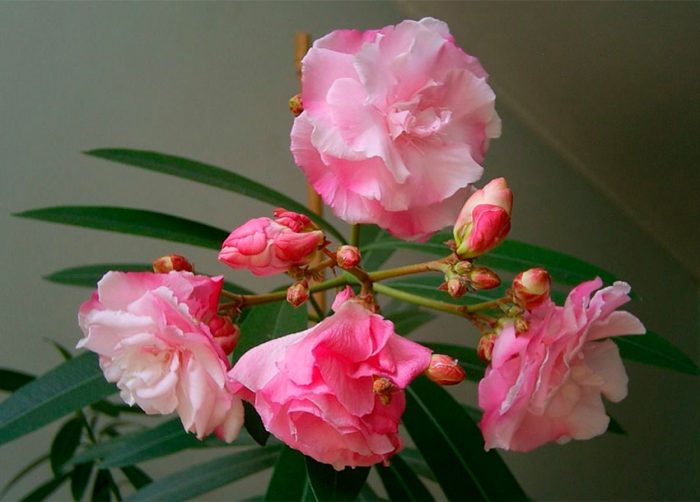
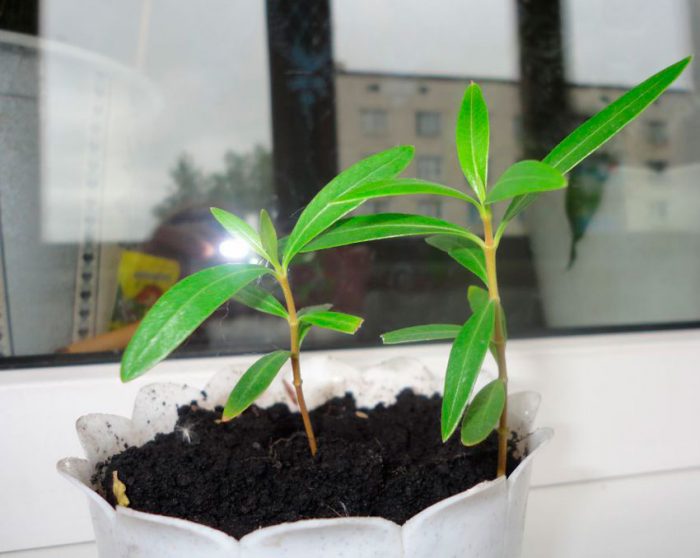
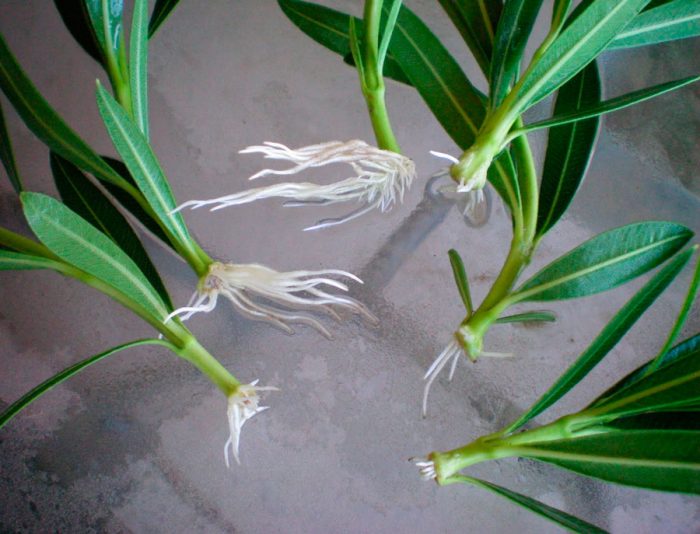
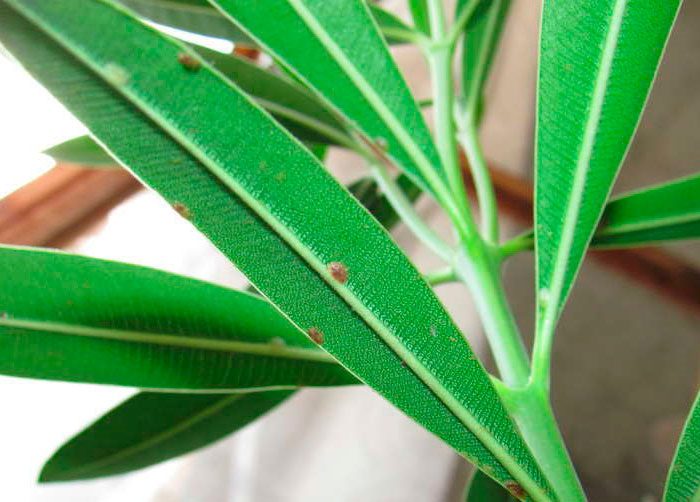
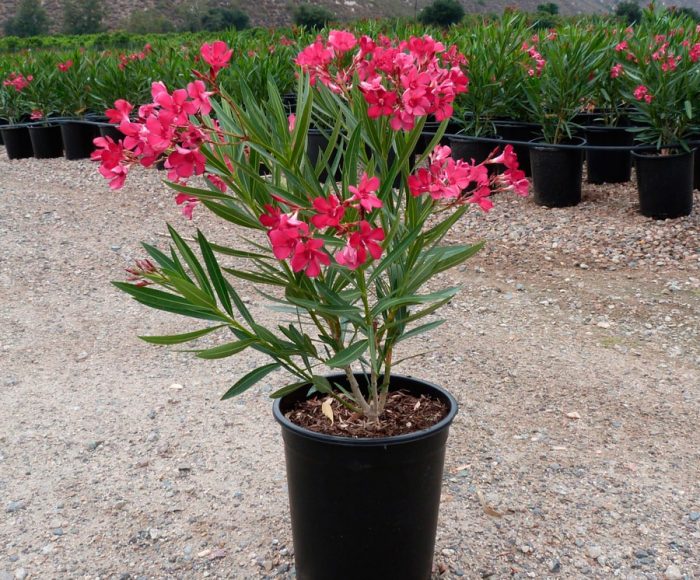

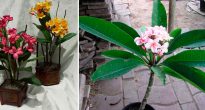

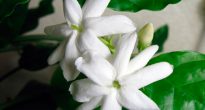
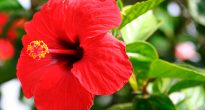



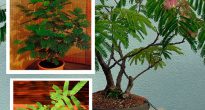

hello. my oleander is over 20 years old. blooms. stands in the room. on the windowsill. all of a sudden, all the dried up leaves became as if they were metal, some kind of stained, watered, cut off. I don't understand. What happened?